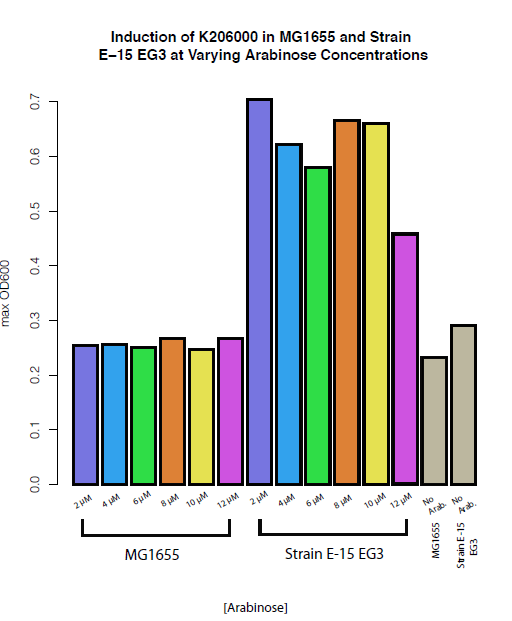Toxicity of EG Graph for MG1655 and DH5a
We observed that EG is non-toxic to both DH5a and MG1655 cells, as evident from the growth of the two strains. Both strains were exposed to LB media containing varying amounts of EG, ranging from 0 mM to 150 mM.

E-15 EG3 in Ethylene Glycol Graph
Knowing that Strain E-15 EG3 utilizes ethylene glycol, we devised an experiment to test the optimal amount of ethylene glycol the strain would thrive in. From the graph, we deduced that 30 mM of ethylene glycol showed the highest growth rate, which also matched previous data provided in the referenced paper [1].
Arabinose Optimization for MG1655 and E-15 EG3

The point of this Tecan experiment was to see the optimal amount of arabinose in the different strains. In MG1655, it seems that all concentrations of arabinose give about the same maximum OD as the control with no arabinose. Strain E-15 EG3 shows a higher deviation in growth for 2 µM, relative to the 8 µM and 10 µM samples. However, all amounts of arabinose had a significant increase in OD due to the arabinose induction, compared to the no arabinose control. From our data, we see that the 2 µM, 8 µM, and 10 µM are the top three concentrations of arabinose in terms of the maximum OD. The K206000 data page shows that 10 µM has the maximum induction with arabinose, similar to our data observed from this experiment. These two sources demonstrated that 10 µM of arabinose had high induction, leading us to use that concentration in following experiments. The parts registry’s data page did not show optimal induction for 2 µM, but it had the highest maximum OD in our experiment, which is why we included it in our subsequent experiments too.
Directed Evolution of Strain E-15 EG3

For directed evolution, when we repassaged Strain E-15 EG3 in new media, we saw a general increase in growth rate over time. We ran two trials at the same time in two separate tubes, which we are going to call Tube 1 and Tube 2. For Tube 1, we saw a 74.8% increase in growth rate from the original strain and for Tube 2, we saw a 227.84 % increase, both over a time period of 285.95 hours.
Ethyl Methanesulfonate Results


Our Tecan experiments for the MG1655 with 0 and 45 minutes of EMS and E-15 EG3 with 0 and 45 minutes of EMS are meant to show which colonies have a higher maximum OD after growing in a Tecan. The bars colored red represent the colonies with the top three highest maximum OD600 readings. However, it seems that they had the highest OD reading because a precipitate formed on the bottom of the plate. In the near future, we will optimize our conditions for these Tecan runs to prevent such precipitates from forming.


 "
"











